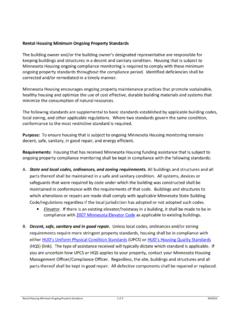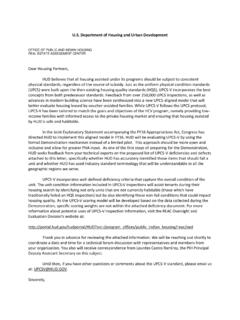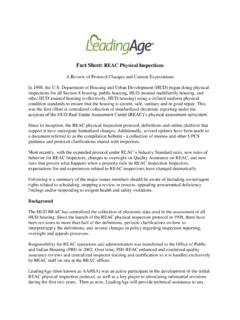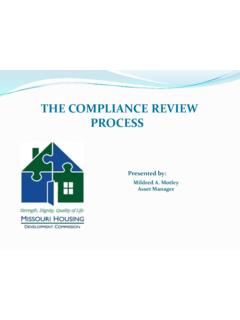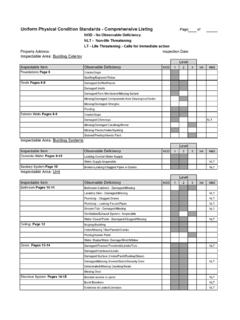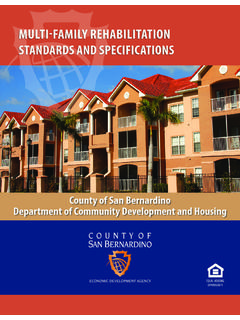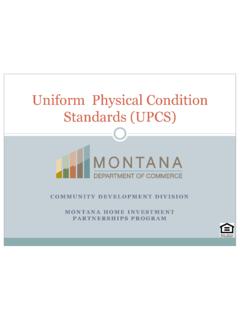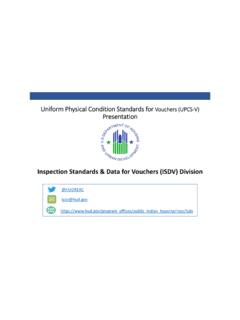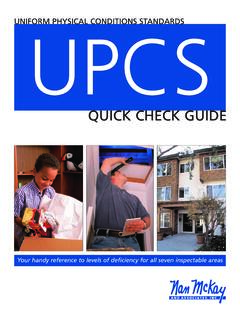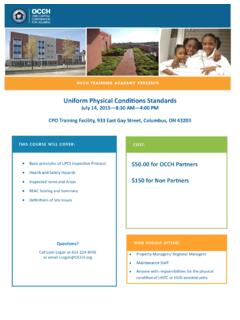Transcription of HEALTH IMPACT - Ohio Housing Finance Agency (OHFA)
1 HEALTH IMPACT ASSESSMENTA lignment of Affordable Housing physical Inspection Policies of OhioHolly Holtzen, Housing Finance AgencyOffice of Affordable Housing Research and Strategic PlanningElizabeth Klein, MPH, Hood, Keller, MPHThe Ohio State UniversityCollege of Public HealthAcknowledgmentsThis HEALTH IMPACT Assessment is supported by a grant from the HEALTH IMPACT Project, a collaboration of the Robert Wood Johnson Foundation and The Pew Charitable Trusts. The views expressed are those of the author(s) and do not necessarily reflect the views of The Pew Charitable Trusts or the Robert Wood Johnson Foundation. The views expressed are those of the author(s) and do not necessarily reflect the official policies or views of the State of Ohio or the Ohio Housing Finance Agency (OHFA). OHFA will consider the recommendations of the HIA when planning and administering its programs and SummaryPage 4 Affordable Housing provides a platform to improve population HEALTH by increasing the availability of low-cost Housing as well as ensuring a healthy built environment for vulnerable populations.
2 Housing quality contributes to tenants HEALTH status in a variety of ways. Healthy, affordable rental options, such as those funded through local, state, and federal monies, are an opportunity to promote HEALTH equity. This is especially important as HEALTH disparities are often seen in low-income populations, and have been linked to the availability of quality Housing . Therefore, maintaining the quality of affordable rental options is necessary to ensure a positive lasting IMPACT for the tenant and surrounding Quality and SafetyHousing quality and safety have emerged as key factors impacting physical and mental HEALTH . High quality and safety standards are paramount because affordable Housing serves vulnerable populations, including low-income renters, those with mental illness, those with developmental disabilities, and the formerly homeless. Housing quality issues include indoor moisture, visible mold, pests, lead paint, fire risks, and other factors that indicate general deterioration of maintenance.
3 These types of issues are likely to be identified during physical inspections, and there is a substantial literature on these Housing quality issues and associated HEALTH effects. Substantial evidence exists for an association between an exacerbation of asthma and other respiratory illnesses, chronic diseases, poisoning, and injuries and poor living conditions . Evidence for the effects of Housing conditions on mental HEALTH was weak to moderate. The strongest evidence that changing Housing conditions improves HEALTH was found for asthma and other respiratory diseases, lead exposure, and a few types of injuries. physical InspectionsThe physical inspections of affordable rental Housing are a key mechanism to be certain that these properties meet quality and safety standards . These physical inspections follow the uniform physical Condition standards (UPCS), which is a protocol designed to ensure that affordable Housing properties are decent, safe, sanitary and in good repair while maintaining objectivity and uniformity in reporting standards .
4 The UPCS physical inspections focus on exigent HEALTH and safety hazards. Since affordable properties rely on multiple layers of funding and subsidies from the Department of Housing and Urban Development (HUD), Department of Agriculture Rural Development (USDA RD), and Low-Income Housing Tax Credits (LIHTC) administered by state Housing Finance Agencies (HFAs), many affordable properties undergo multiple, yet similar, physical inspections to confirm compliance with program and funding response to declining state and federal funding, the White House Domestic Policy Council began a pilot program to reduce the frequency of physical inspections of affordable Housing properties. This so called physical inspection alignment is being pilot tested in six states, including Ohio, and the Interagency Rental Policy Working Group is considering widespread implementation. This policy decision focuses on increasing the efficiency of the current physical inspection process; as such, the policy decision does not consider HEALTH EXECUTIVE SUMMARYH ealth IMPACT AssessmentPage 5impacts of the resulting alignment process.
5 Given the established correlation between Housing and HEALTH , this HEALTH IMPACT Assessment (HIA) was warranted to examine the HEALTH impacts of the proposed alignment of physical inspections. This HIA was driven by five research questions:QuestionKey Findings1. Are there differences between various types of Housing inspections and what proportion of inspections finds quality problems? Do the rates of problems differ depending on the Agency doing the inspection?Since physical inspections are the only regular mechanism in place to detect Housing quality issues, we first wanted to understand the baseline prevalence of HEALTH -related Housing quality issues in the portfolio of affordable Housing projects in Ohio. The implementation of each physical inspection protocol also varied across funding agencies, which might indicate the rates of HEALTH -related Housing quality issues could differ. If a difference was detected, this may indicate that a reduced frequency of inspections could negatively IMPACT some tenants more than others.
6 Of physical inspections found at least one HEALTH -related quality issue. Frequency of Housing quality issues varied by funding Agency , project size, and project age. The most frequent Housing quality issues were related to appliance and plumbing How many units have more than one inspection? If the number of physical inspections will actually decrease under the proposed policy, how much would disease rates change?If physical inspections were to occur less frequently, tenants living in affordable units may experience poor Housing conditions . This may IMPACT disease risk among vulnerable tenants. Though there is limited evidence that remediating Housing quality issues improves HEALTH outcomes, the strongest evidence indicates that prolonged exposure to certain Housing conditions will result in increased disease relates to asthma, lead and pesticide exposure, and some types of injuries. Properties inspected by more than one funding Agency frequently found the same Housing quality Which of the current types of inspections used is the most HEALTH protective, based on available literature?
7 The reduced frequency of inspections warrants careful consideration of the quality of the physical inspection tools currently in use. If only one Agency conducted an inspection every three years, the inspection protocol selected would need to thoroughly review all Housing quality issues to ensure a healthy and safe living environment. Prevalence of specific HEALTH -related violations ( , fire, pests, mold, appliances, air quality, ground fault circuit interrupter, accessibility, plumbing, and trip hazard) varied by funding Agency , project size, and project SummaryPage 6 QuestionKey Findings4. What evidence is there that physical inspections identify Housing condition problems that would not be addressed by managers/owners in the absence of an inspection?If the frequency of physical inspections was reduced, the time until remediation of Housing quality issues could be extended. Property managers maintenance practices appear to vary and IMPACT their ability to identify HEALTH -related Housing quality issues in the absence of inspections.
8 During qualitative interviews, property managers and tenants identified physical inspections as an impetus for reporting Housing maintenance issues. Inconsistency exists among inspectors within and across agencies, complicating the extent to which Housing condition problems could remain unidentified with fewer How disruptive are physical inspections for tenants?The physical inspection protocol requires inspectors to enter individual Housing units multiple times per year to meet compliance requirements. Tenants living in affordable Housing must give access to their home for these inspections in addition to other inspections required by owners and managers. Aligning the inspection process to reduce the frequency could offer an opportunity to reduce the IMPACT on the resident while continuing to meet compliance regulations. physical inspections have varying effects on tenants, according to how they maintain their unit and prepare for inspections, their physical abilities, and their attitude toward inspections.
9 Tenants with disabilities had the greatest difficulty preparing for physical inspections. Tenants held differing and sometimes conflicting perspectives about physical nature and differential impacts of Housing -related HEALTH issues were assessed through a review of the existing literature, collection of Ohio physical inspection data from three agencies and secondary data sources, and key informant interviews with affordable Housing property managers and tenants in Ohio. (See full report for more details) HEALTH IMPACT AssessmentPage 7 physical HEALTH Alignment: Housing Quality Issues and the IMPACT on Vulnerable Populations in Ohio Asthma and Respiratory SymptomsLiterature: Strong IMPACT on many based on 10+ strong studies. Asthma rates are twice as high among children below 200% of poverty level living in rental Housing as compared to the Findings: Mold and pests were among the most equently cited issues in physical inspections with and of projects with these findings, respectively.
10 Quality of Affordable HousingLiterature: Srong IMPACT on few or small IMPACT on many based on fewer than 5 Findings: e length of time until some Housing quality issues are fixed may be extended depending on the property management practices. Injuries ( falls)Literature: Strong IMPACT on few based on 10+ strong studies. HIA Findings: Trip hazards were equently ( of projects) cited in physical inspections. Literature: Moderate IMPACT on medium number or strong IMPACT on a few based on 10+ strong studies. Literature: Moderate IMPACT on medium number or strong IMPACT on a few based on fewer than 5 ,000 Young Children < Million Low-Income Renters294,000 Low-Income Renters346,000 Adults 55+ and 240,000 Young Children < 5 Mortality ( Fires)Literature: Small IMPACT on a few based on fewer than 5 studies. HIA Findings: Fire-related hazards were among the most cited ( of projects) finding in physical inspections. Frequently, the citation was issued due to missing batteries in a smoke alarm.


